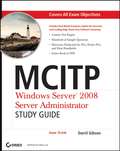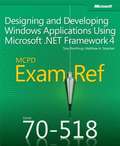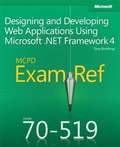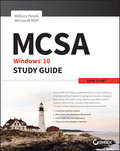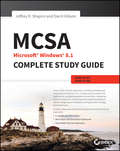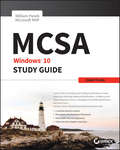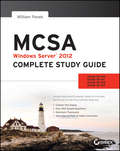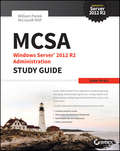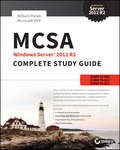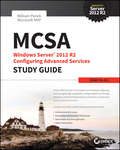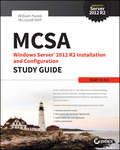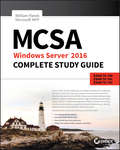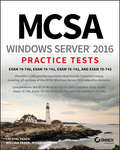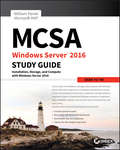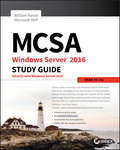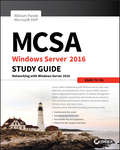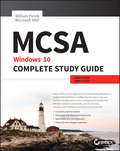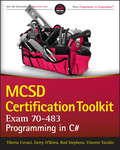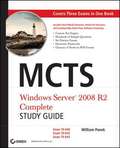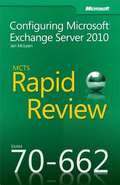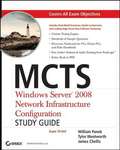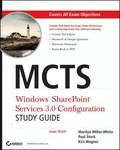- Table View
- List View
MCITP: Windows Server 2008 Server Administrator Study Guide
by Darril GibsonMaster Windows Server 2008 and navigate every detail of Microsoft's new MCITP: Windows Server 2008 Server Administrator exam with the information in MCITP: Windows Server 2008 Administration Study Guide (Exam 70-646, with CD). Learn the infrastructure, Web, and IT application servers and also how to use scripts and batch files to accomplish tasks on a regular basis. As a Server Administrator, you will understand how to manage the server operating system, file, and directory services, distribute software, patches, and updates, profile and monitor assigned servers, and troubleshoot.For Instructors: Teaching supplements are available for this title.
MCPD 70-518 Exam Ref: Designing and Developing Windows® Applications Using Microsoft® .NET Framework 4
by Tony Northrup Matthew A. StoeckerProfessional-level prep for the professional-level exam. Prepare for MCPD Exam 70-518--and help demonstrate your real-world mastery of Windows application design and development with .NET Framework 4. Designed for experienced, MCTS-certified professionals ready to advance their status--Exam Ref focuses on the critical-thinking and decision-making acumen needed for success at the MCPD level. Focus on the expertise measured by these objectives: Designing the Layers of a Solution Designing the Presentation Layer Designing the Data Access Layer Planning a Solution Deployment Designing for Stability and Maintenance
MCPD 70-519 Exam Ref: Designing and Developing Web Applications Using Microsoft® .NET Framework 4
by Tony NorthrupPrepare for MCPD Exam 70-519--and help demonstrate your real-world mastery of web application design and development--with this official Microsoft® Exam Ref. Written for experienced, MCTS-certified professionals ready to advance their status--this guide focuses on the critical-thinking and decision-making acumen needed for success at the MCPD level. With concise, objective-by-objective reviews, strategic case scenarios, and "Thought Experiments", you get professional-level preparation for the professional-level exam. Optimize your exam-prep by focusing on the expertise needed to: Design the application architecture Choose the right server-side and client-side technologies Design the user experience Design data access and presentation Plan for security Choose a testing methodology Plan for scalability and reliability You also get an exam discount voucher--making this book an exceptional value and a great career investment.
MCSA Microsoft Windows 10 Study Guide: Exam 70-697
by William PanekNOTE: The correct URL to access the Sybex interactive online test bank and study tools is www.wiley.com/go/sybextestprep. The book’s back cover, Introduction, and last page in the book provided the wrong URL. We apologize for any confusion and inconvenience this may have caused you.Master 100 percent of Microsoft Windows 10 exam with real-world hands-on practice MCSA: Microsoft Windows 10 Complete Study Guide is your ultimate preparation resource for the new Windows 10 certification. Fully updated to align with the latest version of the exam, this new edition digs deeper into the intricacies of the Windows OS and provides the most up-to-date information on new Windows 10 technologies. With complete coverage of all exam topics, this invaluable guide walks you through device planning, deployment, and management; network and storage configuration; access, data, app, and recovery management, and much more to help you master the exam material. You also get access to the Sybex interactive online learning environment, featuring electronic flashcards, a searchable glossary, an assessment test, and bonus practice exams designed to give you a preview of exam day. MCSA: Microsoft Windows 10 is the Microsoft Certified Solutions Associate certification for Windows 10, testing your abilities in a broad variety of associate-level tasks. This book rounds them up into a comprehensive knowledge base to help you clarify, memorize, and deepen your understanding so you can approach exam day with confidence. Master 100 percent of exam 70-697, Configuring Windows Devices, objectives Get more hands-on practice in real-world scenarios Test your knowledge with challenging review questions Access digital study aids and practice tests for comprehensive prep Windows is the world's leading operating system, with an estimated 90 percent share of the desktop OS market. There are currently over 110 million Windows 10 users, and that number is expected to rise—putting Windows 10 Specialists in high demand in the job market. If you're ready to fill the growing need for trained Windows 10 associates, Microsoft Configuring Windows Devices Study Guide Exam 70-697 has you covered for complete and detailed exam preparation.
MCSA Microsoft Windows 8.1 Complete Study Guide
by Jeffrey R. ShapiroComprehensive, hands-on study guide for the Microsoft Windows 8.1 exams The MCSA: Microsoft Windows 8.1 Complete Study Guide is a comprehensive package loaded with educational study tools, including a pre-assessment test, hands-on exercises, hundreds of review questions, exclusive practice exam questions, electronic flashcards, and over an hour of author-led videos. For IT students and professionals, getting certified on Microsoft Windows 8.1 can mean huge career opportunities. Over 90% of all personal computing devices run on Windows, and those certified on the newest version will be in high demand. This comprehensive resource prepares candidates to master all the exam objectives for the Microsoft Certified Solutions Associate (MCSA): Windows 8.1 exams 70-687 and 70-688, as well as the Upgrade exam 70-689. Through real-world scenarios and hands-on exercises, readers are given a solid background in the most essential concepts they need to know for exams. The book guides readers through installing and upgrading to Windows 8.1, configuring hardware and applications, configuring network connectivity and access to resources, monitoring and maintaining Windows clients, and more. This resource's specialized, practical focus is also a benefit to IT help desk and user support professionals who are simply looking to upgrade their skills in Windows. Serves as an comprehensive, practical study guide for those preparing for their MCSA: Windows 8.1 certification Covers all exam objectives and includes invaluable study tools Guides readers through the installation, deployment, upgrading, and maintenance of Windows 8.1 Offers educational benefits for professionals looking to improve their Windows 8.1 knowledge and skills MCSA: Microsoft Windows 8.1 Complete Study Guide promises not only to prepare readers for the MCSA: Windows 8.1 exams, but also for the scenarios and challenges they will encounter professionally once certification has been obtained.
MCSA Windows 10 Study Guide: Exam 70-698
by William PanekMaster Windows 10 installation and configuration, including new technologies The MCSA Windows 10 Study Guide is the only comprehensive resource you'll need to prepare for Exam 70-698. You'll find expert coverage of 100% of all exam objectives led by expert Microsoft MVP, William Panek. Quickly master the concepts and processes involved in Windows 10 installation and configuration. The Sybex superior study tools and online learning environment include: system requirements, devices, core services, networking, storage, data access and usage, maintenance, updates, data recovery, and more. Real-world scenarios bring on the job experience while hands-on exercises provide practical instruction on critical techniques, and the Sybex online learning environment gives you access to electronic flashcards for last minute review, an assessment test, and bonus practice exams so you can be confident on exam day. Exam 70-698 is the first of two exams for the MCSA certification. Addressing local and desktop deployments, these topics form the foundation of what's to come. This Sybex Study Guide gives you the tools you need along with expert content so you can build the essential knowledge base and master the ley concepts. Clarify processes with hands-on exercises Identify knowledge gaps through chapter review questions Test your understanding with online bonus practice exams and more With a 90-percent market share, Windows is the world's number-one desktop OS. While it may look similar to Windows 8, Windows 10 includes a number of enhanced features that specialists need to know, and MCSA candidates must be able to demonstrate a clear understanding of how to work with these new technologies. MCSA Windows 10 Study Guide: Exam 70-698 is your complete guide to Windows 10 installation and configuration, with expert instruction and practical exam preparation.
MCSA Windows Server 2012 Complete Study Guide
by William PanekPrepare for the MCSA Windows Server 2012 exams with this Sybex study guideMicrosoft's new version of the MCSA certification for Windows Server 2012 requires passing three exams. This value-priced study guide includes more than 1,000 pages of quality exam-prep content, covering 100 percent of the objective domains of all three exams (as well as the Upgrade exam, 70-417). Also includes more than 500 practice questions. You also have access to three bonus exams, electronic flashcards, and videos showing how to perform the more difficult tasks. Both first-time MCSA candidates and those wishing to upgrade from Server 2008 certification will benefit from this complete test-prep guide.Provides a comprehensive study guide for all three MCSA Windows Server 2012 exams: 70-410, 70-411, and 70-412, as well as the Upgrade exam: 70-417Covers installing and configuring Windows Server 2012; deploying and configuring DNS service; administering Active Directory; creating and managing Group Policy Objects; and configuring server roles and features, Hyper-V, and core networking servicesExplains basic networking concepts, DHCP, deploying and maintaining servers, configuring a network policy server infrastructure and high availability in Windows Server 2012, and much moreFeatures real-world scenarios, hands-on exercises, practice exams, electronic flashcards, and over an hour of video demonstrationsCovers all exam objectivesMCSA Windows Server 2012 Complete Study Guide arms you with all the information you must master to achieve MCSA certification on Windows Server 2012.
MCSA Windows Server 2012 R2 Administration Study Guide
by William PanekComplete exam coverage, hands-on practice, and interactive studytools for the MCSA: Administering Windows Server 2012 R2 exam70-411 MCSA: Windows Server 2012 R2 Administration Study Guide: Exam70-411 provides comprehensive preparation for exam 70-411:Administering Windows Server 2012 R2. With full coverage of allexam domains, this guide contains everything you need to know to befully prepared on test day. Real-world scenarios illustrate thepractical applications of the lessons, and hands-on exercises allowyou to test yourself against everyday tasks. You get access to aninteractive practice test environment that helps you avoidsurprises on exam day, plus electronic flashcards and videodemonstrations showing how to perform some of the more difficulttasks.Exam 70-411 is one of three exams you must pass to become aMicrosoft Certified Solutions Associate (MCSA) on Windows Server2012 R2 and a clear path to increasing your value and marketabilityin the workplace. The exam reflects the 2012 update to the OS,including the new enhancements to Hyper-V, Storage Spaces, andActive Directory. This guide gives you the information and practiceyou need to master all aspects of Windows Server 2012 R2 for test.Learn how to:Deploy, manage, and maintain serversConfigure file and print servers, network services, andmoreManage and configure Active Directory and Group PolicyReview real-world scenarios, video, and interactive studyaidsIf you're looking to master Windows server administration beforethe exam, MCSA: Windows Server 2012 R2 Administration StudyGuide is a complete and comprehensive prep tool to give you theconfidence you need to succeed.
MCSA Windows Server 2012 R2 Complete Study Guide
by William PanekPrepare for the MCSA Windows Server 2012 R2 Exams Microsoft's new version of the MCSA certification for WindowsServer 2012 R2 requires passing three exams (or one Upgrade exam ifyou have your MCSA or MCITP in Windows Server 2008). Thisvalue-priced study guide includes more than 1,000 pages of qualityexam-prep content, covering 100% of the objective domains of allthree exams (as well as the Upgrade exam, 70-417).In addition, you get access to an interactive practice testenvironment with more than 500 questions, electronic flashcards,and videos showing how to perform the more difficult tasks. Bothfirst-time MCSA candidates and those wishing to upgrade from Server2008 certification will benefit from this complete test-prepguide.Completely updated to cover the Windows Server 2012 R2ExamsProvides a comprehensive study guide for all three MCSA WindowsServer 2012 R2 exams: 70-410, 70-411, and 70-412, as well as theUpgrade exam: 70-417Covers installing and configuring Windows Server 2012;deploying and configuring DNS service; administering ActiveDirectory; creating and managing Group Policy Objects; andconfiguring server roles and features, Hyper-V, and core networkingservicesExplains basic networking concepts, DHCP, deploying andmaintaining servers, configuring a network policy serverinfrastructure and high availability in Windows Server 2012, andmuch moreFeatures real-world scenarios, hands-on exercises, practiceexam questions, electronic flashcards, and over an hour of videodemonstrationsCovers all exam objectivesMCSA Windows Server 2012 R2 Complete Study Guide arms youwith all the information you must master to achieve MCSAcertification on Windows Server 2012 R2.
MCSA Windows Server 2012 R2 Configuring Advanced Services Study Guide
by William PanekThe bestselling MCSA study guide, with expert instruction andhands-on practice MCSA Windows Server 2012 R2 Configuring Advanced ServicesStudy Guide provides focused preparation for exam 70-412 and isfully updated to align with the latest Windows Server 2012 R2objectives. This comprehensive guide covers 100 percent of all examobjective domains, and includes hundreds of practice questions andanswers. You get access to video demonstrations, electronicflashcards, and practice exams, and hands-on exercises based onreal-world scenarios allow you to apply your skills to everydaytasks. Organized by objective, each chapter includes reviewquestions and a list of Exam Essentials that help you judge yourlevel of preparedness every step of the way.Exam 70-412: Configuring Advanced Windows Server 2012 Servicesis the third and final exam in the MCSA certification series, andwas recently updated to cover Server R2. Additions includeenhancements to Hyper-V, Storage Spaces, and Active Directory, soit's crucial that your study guide be up to date as well. This bookcovers the entire exam, including the new information, withexpert instruction and easy-to-follow explanation that helps youto:Configure network services, high availability, informationprotection, and moreImplement business continuity and disaster recoverysolutionsGet hands-on practice in real-world scenariosPass this one last exam and you become a Microsoft CertifiedSolutions Associate - someone with trusted, demonstratedexpertise in the server software with over 83 percent market share.Businesses rely on Windows Server, and the people who understandthem are in demand. Thorough preparation is the key to examsuccess, and MCSA Windows Server 2012 R2 Configuring AdvancedServices Study Guide provides all the information you need toknow.
MCSA Windows Server 2012 R2 Installation and Configuration Study Guide
by William PanekMaster Windows Server installation and configuration withhands-on practice and interactive study aids for the MCSA: WindowsServer 2012 R2 exam 70-410 MCSA: Windows Server 2012 R2 Installation and ConfigurationStudy Guide: Exam 70-410 provides complete preparationfor exam 70-410: Installing and Configuring Windows Server 2012 R2.With comprehensive coverage of all exam topics and plenty ofhands-on practice, this self-paced guide is the ideal resource forthose preparing for the MCSA on Windows Server 2012 R2. Real-worldscenarios demonstrate how the lessons are applied in everydaysettings. Readers also get access to the interactive practicetests, electronic flashcards, and video demonstration of the moredifficult tasks, which help readers fully understand the scope ofprinciples at work.Exam 70-410 is one of three exams MCSA candidates must take toobtain their MCSA: Windows Server 2012 R2. The test is aligned withthe 2012 update to the Windows server operating system, and so isthe book. This study guide contains everything users need to knowfor the exam, including the 2012 update's changes to Hyper-V andActive Directory. Avoid surprises on exam day, and master thematerial while learning to:Install and configure Windows Server 2012 R2Configure Hyper-V and server roles and featuresInstall and administer Active DirectoryManage Group PolicyExam prep is about more than passing the test--it helps yougain hands-on experience performing more complex operations, givingyou the confidence you need to successfully apply what you'velearned in a work environment. If you're looking to triumph overthe MCSA exam 70-410, MCSA: Windows Server 2012 R2 Installationand Configuration Study Guide: Exam 70-410 provides theinformation and practice you need.
MCSA Windows Server 2016 Complete Study Guide: Exam 70-740, Exam 70-741, Exam 70-742, and Exam 70-743
by William PanekOver 1,000 pages of comprehensive exam prep for the entire MCSA certification process MCSA Windows Server 2016 Complete Study Guide is your ultimate companion on the journey to MCSA certification. Covering exams 70-740, 70-741, 70-742, plus the upgrade exam 70-743, this book walks you through 100 percent of all exam objectives to help you achieve complete readiness. Hands-on exercises strengthen your practical skills, and real-world scenarios help you understand how these skills are used on the job. Over 500 practice questions allow you to test your understanding along the way, and the companion website gives you access to electronic flashcards, practice exams, and over an hour of expert video demonstrations. From basic networking concepts and services to Active Directory and Hyper-V, this guide provides full coverage of critical MCSA concepts and skills. This new edition has been updated for the latest Windows Server 2016 release, featuring the latest exam blueprints for the most relevant coverage. This value-priced guide is three books in one, giving you the most comprehensive exam prep experience for all required MCSA exams. Whether you're starting from the beginning, or upgrading from the MCSA Windows Server 2012 R2 certification, arm yourself with the ultimate tool for complete and comprehensive preparation. Study 100 percent of the objectives for all three MCSA exams, plus the upgrade exam Practice your skills using hands-on exercises and real-world scenarios Test your knowledge with over 500 challenging practice questions Access online study aids including flashcards, video demos, and more! The MCSA exams test your knowledge and skill in installation, configuration, deployment, and administration using a variety of networking tools. The scope is broad, but your complete understanding of the most up-to-date concepts and practices is critical to your success on the exam—and on the job. MCSA Windows Server 2016 Complete Study Guide covers everything you need to know, and gives you the tools to help you learn it.
MCSA Windows Server 2016 Practice Tests: Exam 70-740, Exam 70-741, Exam 70-742, and Exam 70-743
by William Panek Crystal PanekGet prepared for the high-stakes MCSA Windows Server 2016 certification exam Windows Server 2016 is the latest version of Microsoft's Windows server operating system, and the ideal server for Windows 8/8.1 and Windows 10 desktop clients. Windows Server 2016 will include many new and updated features, including enhancements to Hyper-V, Storage Spaces, and Active Directory. MCSA Windows Server 2016 Practice Tests provides 10 unique 85-question chapter tests, covering the ten MCSA Windows Server 2016 objective domains, PLUS three additional 50-question practice exams, for a total of 1000 practice test questions. • Practice tests are a popular way for certification candidates to prepare for taking exams • The practice test questions provide comprehensive coverage of the exam objectives • Covers all three exams: 70-740, 70-741, 70-742 • Written by a five-time Microsoft MVP Winner This book helps you gain the confidence you need and prepares you for taking the three required Exams 70-740, 70-741, and 70-742, or upgrade Exam 70-743. The practice test questions prepare you for test success.
MCSA Windows Server 2016 Study Guide: Exam 70-740
by William PanekThe bestselling MCSA 70-470 study guide, updated for the latest exam MCSA Windows Server 2016 Study Guide is your ultimate resource for Exam 70-740. Covering 100% of all exam objectives, this study guide goes far beyond concept review with real-world scenarios containing expert insights, chapter review questions, hands-on practice exercises while the Sybex interactive learning environment provides additional last minute review through practice exams, electronic flashcards, and searchable glossary. This new edition has been fully updated to align with the Windows Server 2016 exam, featuring authoritative coverage of installation, configuration, server roles, Hyper-V, core network services, Active Directory, Group Policy, security, remote access, disaster recovery, and more. The vast majority of servers around the world use Windows Server, and the 2016 release includes a host of new features and updates. This study guide has been updated to prepare you for these changes so you can be confident on exam day and beyond. Study 100% of Exam 70-740 objectives Gain hands-on practice performing critical tasks Link concept to practice through real-world scenarios Access to the Sybex interactive learning environment Whether you want to sit for the exam, or simply improve your job performance, this Sybex study guide will give you the expert insight to learn the key concepts and latest updates to Windows Server 2016.
MCSA Windows Server 2016 Study Guide: Exam 70-740, Exam 70-741, Exam 70-742, And Exam 70-743
by William PanekComprehensive preparation for the final MCSA exam, updated for Windows Server 2016 MCSA Windows Server 2016 Study Guide: Exam 70-742 is the ultimate preparation resource for the third and final MCSA exam. Tightly focused and highly relevant, this guide provides everything you need to go into the exam fully prepared; expert coverage of all exam objectives helps ensure comprehensive understanding, and hundreds of practice questions help you track your progress and prioritize areas most in need of review. Access to online study aids allows you to study on the go, with electronic flashcards, practice tests, and a glossary to help you get the most out of your preparation plan. Hands-on exercises test your practical skills, while real-world scenarios give you a preview of how MCSA skills and concepts are applied in the workplace. Bestselling author and four-time Microsoft MVP, William Panek, covers server deployment, maintenance, and management; file and print server configuration; network services and access; Active Directory; Group Policy; server infrastructure and more, this book is your comprehensive companion for the latest exam. Study 100 percent of Exam 70-742 objectives, updated for Windows Server 2016 Practice your skills with real-world hands-on exercises Review from anywhere with access to online study aids Assess your readiness with challenging practice exams Windows Server 2016 includes enhancements to Hyper-V, Storage Spaces, and Active Directory, along with many brand new and updated features—all of which are reflected in the latest exam. To ensure complete readiness and avoid exam-day surprises, it is critical that your study resources be up-to-date and comprehensive in scope; MCSA Windows Server 2016 Study Guide: Exam 70-742 covers everything you need to know, with a practical approach that promotes true understanding.
MCSA Windows Server 2016 Study Guide: Exam 70-741
by William PanekOver 1,000 pages of comprehensive exam prep for the entire MCSA certification process MCSA Windows Server 2016 Complete Study Guide is your ultimate companion on the journey to MCSA certification. Covering exams 70-740, 70-741, 70-742, plus the upgrade exam 70-743, this book walks you through 100 percent of all exam objectives to help you achieve complete readiness. Hands-on exercises strengthen your practical skills, and real-world scenarios help you understand how these skills are used on the job. Over 500 practice questions allow you to test your understanding along the way, and the companion website gives you access to electronic flashcards, practice exams, and over an hour of expert video demonstrations. From basic networking concepts and services to Active Directory and Hyper-V, this guide provides full coverage of critical MCSA concepts and skills. This new edition has been updated for the latest Windows Server 2016 release, featuring the latest exam blueprints for the most relevant coverage. This value-priced guide is three books in one, giving you the most comprehensive exam prep experience for all required MCSA exams. Whether you're starting from the beginning, or upgrading from the MCSA Windows Server 2012 R2 certification, arm yourself with the ultimate tool for complete and comprehensive preparation. Study 100 percent of the objectives for all three MCSA exams, plus the upgrade exam Practice your skills using hands-on exercises and real-world scenarios Test your knowledge with over 500 challenging practice questions Access online study aids including flashcards, video demos, and more! The MCSA exams test your knowledge and skill in installation, configuration, deployment, and administration using a variety of networking tools. The scope is broad, but your complete understanding of the most up-to-date concepts and practices is critical to your success on the exam--and on the job. MCSA Windows Server 2016 Complete Study Guide covers everything you need to know, and gives you the tools to help you learn it.
MCSA: Exams 70-698 and Exam 70-697
by William PanekThe go-to MCSA prep guide, updated for Windows 10 and the new exams MCSA Windows 10 Complete Study Guide is your comprehensive resource for taking both Exams 70-698 and 70-697. Covering 100% of all exam objectives, this study guide goes beyond mere review to delve deeper into the complex topics and technologies to help you strengthen your understanding and sharpen your skills. Written by a veteran Microsoft MVP, this guide walks you through MCSA skills in context to show you how concepts are applied in real-world situations. Hands-on exercises speed the learning process and facilitate internalization, while review questions challenge and test the depth of your understanding. You also get access to the Sybex interactive online learning environment, featuring flashcards, videos, an assessment test, and bonus practice exams to face exam day with confidence. The MCSA certification process has changed; Exam 70-698 tests your skills in installing and configuring Windows 10, and then Exam 70-697 gauges your abilities in configuring Windows devices. This book is your ideal companion to study for both exams. Study 100 percent of the objectives for Exams 70-698 and 70-697 Apply your knowledge with hands-on exercises Test your skills with challenging review questions Access videos, electronic flashcards, a searchable glossary, and bonus practice exams The demand for qualified Windows 10 professionals will be high, as more than half of the corporate user base that skipped Windows 8/8.1 is expected to adopt Windows 10. If you want the skills that are in demand, you need to get certified; if you're ready to get serious about the exam, MCSA: Windows 10 Complete Study Guide is the resource you shouldn't be without.
MCSD Certification Toolkit (Exam 70-483): Programming in C#
by Rod Stephens Tiberiu Covaci Vincent Varallo Gerry O'BrienA perfectly crafted prep guide that prepares you for the MCSD 70-483The MCSD 70-483 exam is the entry-level Microsoft certification exam for C# developers and this must-have resource offers essential coverage of the exam that will test your competency in C# programming. Each chapter covers one of the core subject domains that comprise the exam. Among the authors are experienced trainers who advised Microsoft on the development of its certification programs, affording them a unique understanding of both the objectives and what it takes to master them. This invaluable knowledge is passed to you so that you will not only be prepared to take the exam, but also become a better C# developer Features a step-by-step lab tutorial for each lesson covered in the book, encouraging you to practice what you've just learned in order to reinforce your learningIncludes an accompanying website that includes more than 100 simulated test questions and answersShares solutions to the hands-on labs presented in the bookContains complete sample codeOffers a unique author approach that not only teaches you how to answer a set of exam questions but also provides you with an understanding of the underlying concepts and skills needed to succeed as a professional C# programmerMCSD Certification Toolkit is all you need to fully prepare for exam 70-483!
MCTS
by William PanekThe must-have study guide for all three Windows Server 2008 R2 MCTS examsNetwork administrators boost their value to their employers with certification, and Microsoft?s three Windows Server 2008 exams offer certification specialties in configuring Active Directory, Network Infrastructure, and Applications Infrastructure. With complete coverage to prepare you for all three exams, this comprehensive study guide has three times the value. Real-world scenarios and hands-on exercises supplement the information to facilitate learning.The three Windows Server 2008 R2 exams (70-640, 70-642, and 70-643) are the first step in achieving Microsoft Certified Technology Specialist status; this complete study guide covers all threeIncludes information on installing and configuring Microsoft exchange servers; monitoring and reporting; configuring recipient and public folders, exchange infrastructure, disaster recovery, addressing and services, name resolution, network access, and remote desktop services; monitoring and managing network infrastructure; and deploying serversSupplemented with plenty of hands-on exercises and real-world scenarios to prepare you for the exam and the work beyondAnyone planning to take exam 70-640, 70-642, or 70-643 will be better prepared with MCTS: Windows Server 2008 R2 Complete Study Guide.
MCTS 70-662 Rapid Review: Configuring Microsoft® Exchange Server 2010
by Ian McleanAssess your readiness for MCTS Exam 70-662--and quickly identify where you need to focus and practice. This practical, streamlined guide walks you through each exam objective, providing "need to know" checklists, review questions, tips, and links to further study--all designed to help bolster your preparation. Reinforce your exam prep with a Rapid Review of these objectives: Installing and Configuring Exchange Servers Configuring Exchange Recipients and Public Folders Configuring Client Access Configuring Message Transport Monitoring and Reporting Implementing High Availability and Recovery Configuring Message Compliance and Security Features This book is an ideal complement to the in-depth training of the Microsoft Press® Training Kit and other exam-prep resources for Exam 70-662.
MCTS 70-680 Rapid Review: Configuring Windows® 7
by Orin ThomasAssess your readiness for MCTS Exam 70-680--and quickly identify where you need to focus and practice. This practical, streamlined guide walks you through each exam objective, providing "need to know" checklists, review questions, tips, and links to further study--all designed to help bolster your preparation. Reinforce your exam prep with a Rapid Review of these objectives: Installing, Upgrading, and Migrating to Windows 7 Deploying Windows 7 Configuring Hardware and Applications Configuring Network Connectivity Configuring Access to Resources Configuring Mobile Computing Monitoring and Maintaining Systems That Run Windows 7 Configuring Backup and Recovery Options
MCTS Windows 7 Configuration Study Guide
by William PanekPrepare for certification in Windows 7 configuration with this all-new study guide This comprehensive book guides readers through preparation for Microsoft's brand new MCTS: Windows 7, Configuring exam (70-680). You'll find 100% coverage of all exam objectives; practical, real-world scenarios; hands-on exercises, and challenging review questions, both in the book and on the CD included with the book. Prepares you for the new exam 70-680, the Microsoft Certified Technology Specialist certification for Windows 7; Windows 7 is Microsoft's new operating system releasing in late 2009 Shows you how to install, configure, and maintain Windows 7 for the exam Covers upgrading and migrating; deploying Windows 7; configuring hardware applications, network connectivity, access to resources, and mobile computing; monitoring and maintaining; handling backup and recovery, and more This is the ideal guide to prepare you for Microsoft's new Windows 7 certification. Note: CD-ROM/DVD and other supplementary materials are not included as part of eBook file.
MCTS Windows Server 2008 Active Directory Configuration Study Guide
by William Panek James ChellisWith Microsoft's release of Windows Server 2008 and a new generation of certification exams, IT administrators have more reason than ever to certify their expertise in the world's leading server software. Inside, find the full coverage you need to prepare for Exam 70-640: Windows Server 2008 Active Directory, Configuring, one of three specializations in the Microsoft Certified Technology Specialist (MCTS) certification track. You'll find full coverage of all exam objectives, practical exercises, real-world scenarios, challenging review questions, and more.For Instructors: Teaching supplements are available for this title.
MCTS Windows Server 2008 Network Infrastructure Configuration Study Guide
by William Panek James Chellis Tylor WentworthEfficiently prepare for the Windows Server 2008 certification exam with MCTS: Windows Server 2008 Network Infrastructure Configuration: Exam 70-642, a comprehensive study tool that will guide you through everything you need to know for the test. This study guide includes 100% coverage of the exam objectives, real world scenarios, hands-on exercises, and challenging review questions, both in the book and on the CD. With Microsoft's release of Windows Server 2008 and a new generation of certification exams, you have more reason than ever to certify your expertise. For Instructors: Teaching supplements are available for this title.
MCTS Windows SharePoint Services 3.0 Configuration Study Guide
by Marilyn Miller-White Paul Stork Kris WagnerThe first and only Study Guide for the MCTS Windows SharePoint Services 3.0 Configuration Exam (70-631)Windows SharePoint Services 3.0 is a free collaborative tool that allows you to share and organize documents, contacts, and calendars; create polls; moderate the content of lists and share libraries; and more. Exam 70-631 tests your knowledge of SharePoint Services 3.0 and this book sharpens your skills as you prepare to take Exam 70-631.Packed with chapter review questions, real-world scenarios, and hands-on exercises, this study guide also readies you for specific aspects of Exam 70-631, including: deploying Windows SharePoint Services 3.0, monitoring SharePoint Services, configuring security for SharePoint Services, administering SharePoint Services, managing customization, and configuring network infrastructure for SharePoint Services.First and only study guide to cover MCTS Windows SharePoint Services 3.0 Configuration Exam (70-631)Examines deploying, monitoring, and administering SharePoint Services, which are specific topics featured in Exam 70-631CD features two practice exams, electronic flashcards, interactive chapter review questions, and the book in a searchable PDFWith this unique study guide, you'll be armed and ready as you prepare to take Exam 70-631.Note: CD-ROM/DVD and other supplementary materials are not included as part of eBook file.
